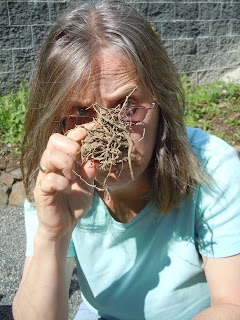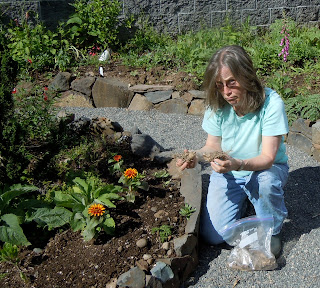When winter comes, I turn my back on the flowers I’ve loved all season. See you next spring, if you make it, I say, and then they’re on their own. Well, that’s one difference between my friend Julie Zickefoose and me. She’s a mom, for keeps, and she will tuck her tender plants into her greenhouse and turn on the heat and read to them when they’re sick, and come spring they will lick her face and be ready to go out and play, and some of them will have wrens nesting in them that need to be tended to as well. And somehow everybody will get the care he or she needs. Julie is the sort to see everyone’s potential. That’s what happens when you spend a lot of time caring for baby birds. You see what a wonderful thing can come from what looks, at first, to be an articulated loogey.
 |
| An Articulated Loogey |
So we were hauling things out of her greenhouse, and she comes upon a bucket of something or other and says “Oh! Would you like some tuberoses?” and then she shovels something into a Ziploc bag for me and that’s how I came home with a suitcase full of tuberoses, whatever they are. They look like dried-up old men’s ears and noses with the sproingy hairs still attached. I do have faith, as much as any mustard seed, and my faith tells me that Julie would not steer me wrong, but my faith does not go so far as to tell me these particular plants are going to make it. I do not know what a tuberose looks like, and that’s not a good sign. It means probably no one grows them in my area and if no one grows them in my area there’s probably a good reason.
Still, I’m giving it a go. I went to the Googles and looked up tuberose, and this is what I found, from a Derek Dyer:
Before you begin to plant/order your bulbs, I want to share this with you: The tuberose is one of the most beautiful flowers that our GOD has placed upon His creation. What a blessing it will be for you and your family to witness the tuberoses growing. I tell my customers that the tuberose is e-z to grow, a very hardy plant and that it is “tuff as nails” and to just wait patiently after planting on the Lord (see Psalm 27:14 KJV). Thank you and enjoy!!
Well, I’m all for giving credit where credit is due, but right away I see a problem. I expect most anything would thrive if planted on the Lord, but all I have to plant on is a fudgy acidic clay studded with river rocks. The rocks are all over, and everyone in Portland complains about them. They came to us courtesy of the Bretz Floods, which repeatedly inundated this area about 15,000 years ago, when, by some accounts, the world was without form and void, and darkness was on the face of the deep. The Bretz Floods are named after J Harlen Bretz, who had an uphill battle persuading anyone he was not nuts. Darwin had changed the scientific scene, and incrementalism was now in favor, so explaining things using floods of biblical proportions was no longer fashionable. But Mr. Bretz was proven out, and we now know our garden rocks came to us from Montana. The Lord in his wisdom knew that we would eventually invent the post-hole digger, and he sent us all these rocks in order to make us meek, putting us in a good position to inherit the earth.
So that’s what I have to plant my tuberoses in. I’ll be pulling for them, but it looks like they want a long growing season, which means I should have started them months ago, when it rained for forty days and nights, and that was just in March. It’s not going to be easy in an area we don’t always eke out a tomato.
I looked up the psalm to see if there were any specific gardening instructions but it just told me to wait on the Lord. And that’s fine with me. I’ve been waiting for ten years for my frost-free gardenia to either bloom or die outright, so I’ve got lots of patience. I’m just afraid I’ll wait all summer and find out the Lord is hanging out in Acapulco with the tuberoses.



Hope to find a picture on line of a tuberose so I can see what is so cool about them. Good luck!
Evidently it's not the picture, unless it's a Scratch 'n' Sniff.
The waiting is the hardest part..well, and the watering/weeding/fertilizing/hoeing etc.
They're doomed!
The pictures won't tell you the most impressive thing about tuberose. They are FRAGRANT! They are heavily, swooningly, tropically perfumed. Are you familiar with "Iz", the late Hawaiian singer with the voice of an angel, the heart of a Buddah, and the build of a sumo wrestler? The tuberose aroma is like that.
Hope you succeed with them. They are heavenly.
Oh yay! Roxie is a local! So you've grown them? Wrestled with them?
They seem to feature prominently in perfumes and leis, according to Google images, you ought to smell good if they find favor with your clay and climate.
I like to think of our stony soil as "well-drained" it is less frustrating.
I like to think of it as well-drained too, but the clay pretty much takes care of that illusion.
Best of luck with them — they will make your garden smell heavenly…
I like that kind of faith.
They do indeed smell like amazing. I'm not sure I would call them beautiful- not in your traditional roses and daisies kind of way, but they are certainly unique and will stink up your everything like yummy.
I can't imagine a nicer thing a plant could do but stink up my everything like yummy.
Hmm, they're beautiful, but it says you have to lift them every year unless you live in Zone 8.
My Zone 2b garden just ain't gonna cut it, and I have approximately the same maternal instincts as a sea turtle: Dump it in the ground and walk away. If it survives, it was meant to be. If not, oh well, there's always next year.
For me, it's sometimes a fine line between "planting" and "giving it a decent burial"…
For me too, although I think it has to do with a very scattered attention span. It's probably a good thing I didn't have kids. I didn't have kids, did I?
If you keep using all these scriptural allusions, we will start numbering you among the saints. And include Dave by proxy.
I hope those tube roses bring joy and distinction to your garden. I have it on good authority that the Lord will be in both Acapulco and Portland this sumer (though I'm not certain about which Portland neighbourhoods).
Time for a cup of tea. There is a steep learning curve to brewing tea. I think my tea has steeped long enough.
Blessings and Bear hugs from Canada.
I gratefully accept and roll around in your Canadian bear hugs. Here's a question for you: why is a disproportionate number of my commenters from Canada?
If the Lord visits our neighborhood, he's a liberal for sure.
Murr, I'll be anticipating a future report on those tuberoses. I fear your climate is much like ours here on the CA central coast = COOL. And as you read, tuberoses are tropical: they love hot and muggy. So if you do succeed, maybe the Lord has given you…or the tuberoses…special powers. Or provided you with global warming so your climate can give the plants what they want. No, wait, I hear it isn't the Lord who is in charge of global warming! Anyway, please do report if they bloom. And are fragrant of course.
If that is true about tuberoses, then we have nothing in common. We had such a marvelous day today. Did it climb all the way up to 75? Not sure. Heaven on earth.
Hmmm. Looks like you're gonna be blogging for at least ten more years or until we find out what a whatzit rose is.
I will happily admit that I haven't run out of material yet. I would never have thunk it, but I'm good for two a week so far.
glad to hear that!
I didn't know what the tuberoses were so I googled them to see what they looked like. They're fine looking flower clusters, but it sounds like it is the fragrance that is the god-seller with them. I wish you the best of luck. I hope they grow and you can take pictures of them for us. I'll have to imagine the smell. 😉
Oh, Rita, I'm afraid I'll have to, too!
Dream on, Sweet Murmurrs!
Had one of those days. Came home to a new blog from you. Makes it all worth while, and we know the tuberoses are in good hands. Actually, I put them in pots on my deck, because Virginia is nothing but ugly hard pan clay, and that is hard on everyone, including me and the tuberoses!
Did I know you were from Virginia? As many of the best folks are. Now see what you can do about that voting problem.
Murr, you put me on the floor every time. I mean, "articulated loogie"? YOU are a piece of very good work.
It takes one to kn….
I too am of the plant and walk away ilk. That sentence could have used a little more punctuation, I think. Anyhow, good luck with the tuberoses; even something that smelled really good wouldn't get me to plant it unless it could survive with no further attention.
Every time I get into a sentence like that, I over-hyphenate. You've probably noticed. I'd have done "plant-and-walk-away ilk." Which is a pain in the ass. I'm a good typer but I can never hit that hyphen. So then I'm deleting = marks and ) marks and eventually jamming all the hyphens in there, like some crazed German. Not that they do that. They just ram the whole word together. Am I rambling again?
Rambling? Yes. Amusing? Very!
I generally over-hyphenate also. Which is why I left them out that time. Shoulda kept them 🙂
Diane Henders-I love you! Now this is going to be my reasoning as I watch all of my good intentions in planting flowers wilt away…I didn't plant them, I BURIED them. Perfect!
Be careful with that god visiting Portland concept, s/he/it/them could be in Maine!
If there is a god, s/he/it is in Maine. And is impervious to black flies and mosquitoes. That's how you can tell, in fact.
They smell divine. Sadly they are also quite killable. Either my care (or that of the cats) was insufficient (over overly efficient). Sigh.
I've heard gardenias smell nice too, but I can't get mine past the push-up-four-leaves and plotz stage. Sucker wont die, though.
I have the same attitude about plants. I place them gently in the ground, say a prayer, and sprinkle with water (not holy water) and leave them on their own. I figure that is the best way for them to survive. I remember a story I once read where a man observed his neighbor always hitting a small tree in his yard with a rolled up newspaper. He thought this was odd, and finally asked his neighbor why he did it and if he did not like the tree. The old man said,"I am helping it to grow strong. If I coddle it, then it will not be strong enough to withstand strong storms and will dying. But if I give it a few smacks each day, it will grow strong and straight and not die. It is a bit like raising children; you should not always coddle and protect them for it will make them weak and they will not be able to stand up on their own."
Every time I coddle a plant, it dies. I'm going to start whacking them with newspapers…
It all reminds me of that comedian who pondered the advice that you should talk to your plants so they would thrive. He didn't deny it, but he couldn't see why they wouldn't respond better to "GROW, you green goof!"
Yes, I use that ol' waiting ruse, too. "Oh we can't plant anything there…I'm waiting for the schmegelias to come up."
"No, dear, we don't need more plants to fertilize, water, prune and deadhead. We have no place to plant them…we're waiting for the schmeglias to come up."
I think if anything ever came up in my "Open" spots, I'd have to Round-Up it.
Ha! What IS an open spot, anyway? You should see what came up in our new asparagus trench. Not asparagus, I'll tell you.
O I liked the articulated loogies. Ours were fledged unarticulated Eastern Phoebes. They hatched ugly on our porch and later flew away beautiful with tails bobbing…. :
I've still got my fingers crossed for my chickadee puppies. They never made it out of their box last year, but now they should be due out tomorrow. I understand they will look just like the adults. So all I'm looking for is a surfeit of chickadees, some of them whiney.
Let's hope this works. Had to switch browsers to be able to comment. We'll see if it posts!
Thank you for stopping in at my blog and for the funny comment 🙂 I enjoy your writing and style.
Ooo I hate when browsers get all huffy! Thanks for making the effort. I can only get my "share" button to work about a third of the time, too. I need a geek.
You absolutely crack me up.
"And that's how I came home with a suitcase full of tuberoses, whatever they are. They look like dried-up old men's ears and noses with the sproingy hairs still attached"
Good for you. I can't garden to save my life. Poor plants don't stand a chance in my care.
Whenever I pass a really nice garden, I tell myself the flowers are all coddled. That sort of takes them down a notch.
We always figure that plants have to do their part. We get the damn things, usually from a nursery, dig a hole, fertilize a bit, splash some water on 'em — and then it is up to them. It takes two to Tango and I did my dance step solo — now it is their turn.
Doesn't work.